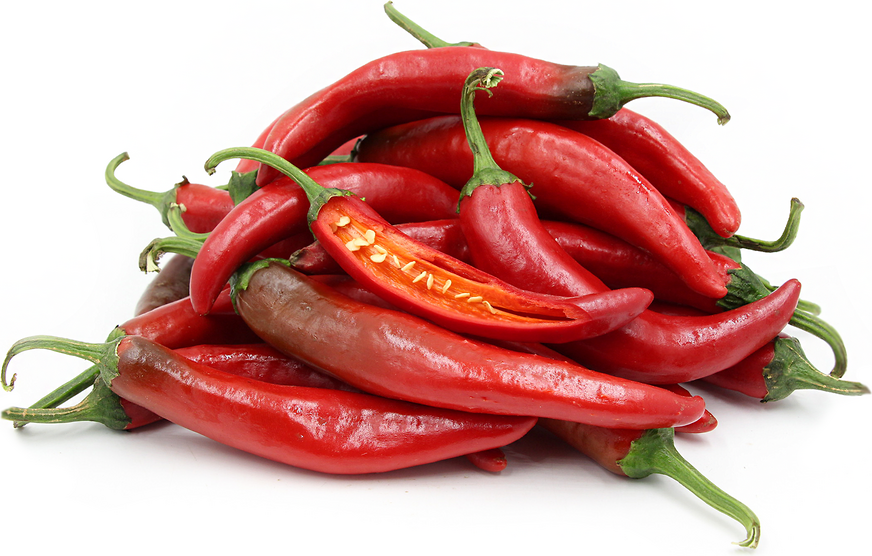


Red Korean Hot Chile Peppers
Estimated Inventory, lb : 0
Description/Taste
Red Korean Hot chile peppers are elongated, curved to straight pods, averaging 8 to 10 centimeters in length, and have a conical shape tapering to a point on the non-stem end. The skin is waxy, glossy, and smooth, ripening from green to red when mature. Underneath the surface, the thick flesh is crisp, lightly striated, and red, encasing a central cavity filled with round and flat, cream-colored seeds. Red Korean Hot chile peppers have a sweet and sour flavor mixed with a mild to moderate level of spice.
Seasons/Availability
Red Korean Hot chile peppers are available in the summer.
Current Facts
Red Korean Hot chile peppers, botanically classified as Capsicum annuum, are mature, bright red pods that belong to the Solanaceae or nightshade family. Native to Korea, there are many different varieties of Red Korean Hot chile peppers that are generally labeled under the Korean Hot chile pepper name in local markets. Red Korean Hot chile peppers are less commonly used in every day, fresh applications in comparison to their young, green counterparts, but their developed, mature flavors make them suitable for drying and grinding into the famous chile powder known as gochugaru.
Nutritional Value
Red Korean Hot chile peppers are an excellent source of vitamins C and B12 and contain potassium, folate, fiber, and a small amount of vitamin A. They also contain a moderate amount of capsaicin, which is the chemical compound that triggers the brain to feel the sensation of heat or spice. Capsaicin provides anti-inflammatory and antioxidant properties.
Applications
Red Korean Hot chile peppers are best suited for raw or cooked applications such as sautéing or stir-frying. The peppers can be chopped into salads, minced into hot sauces, marinades, and dressings, sliced into slaws, or chopped with other vegetables into stir-fries. The peppers can also be stuffed with grains, cheeses, and meat, fried for a crispy appetizer, or roasted for a smoky flavor. In Korea, the most popular use for Red Korean Hot chile peppers is for making gochugaru, which is dried Korean chili powder. Most families in Korea make their own powders with varying ingredients, and the peppers are either sun-dried or dried in a very low-temperature oven. The dried peppers are then traditionally taken to a local rice mill, or bangatgan, to have the pods ground into the preferred size. Red Korean Hot chile peppers are also chopped and added to spicy soups with fish, meat, or vegetables, made into a paste for spicy broths, used as a marinade, or utilized as a dipping sauce. Red Korean Hot chile peppers pair well with garlic, onions, scallions, ginger, rice, noodles, sesame seeds, bok choy, asparagus, carrots, spinach, mushrooms, dried anchovies, tofu, and meats such as beef, poultry, pork, and fish. Fresh peppers will keep up to two weeks when stored whole and unwashed in a plastic bag in the refrigerator.
Ethnic/Cultural Info
In Korea, kimchi is a traditional condiment made from cabbage, radish, ginger, garlic, and gochugaru, which is the ground Red Korean Hot chile pepper powder. These items are mixed together, salted, and then fermented for at least a week. The spicy, fermented cabbage is a popular condiment in Korea and is consumed at almost every meal, favored for its sour, tangy, spicy, and crunchy nature. It is believed that kimchi provides digestive benefits by acting as a probiotic and also offers benefits to the metabolism. The sour side dish was primarily localized to Korea until the Seoul Olympics in 1988. Through television highlights and promotional marketing, the demand for kimchi abroad increased, and many home chefs are now making their own versions of kimchi using local ingredients and personalized flavors. Kimchi is also traditionally still made in November in Korea to store vegetables for the cold winter season.
Geography/History
Red Korean Hot chile peppers are native to the Korean peninsula and are descendants of peppers originally from Central and South America. The original varieties were introduced to Europe and Asia via Spanish and Portuguese explorers in the 15th and 16th centuries and were likely spread to Korea via Silk Road trade routes through China. In Korea, the peppers adapted to the short, hot, and humid summers and became highly cultivated for their spicy flavors. Today Red Korean Hot chile peppers can be found throughout Korea at local markets and may be spotted in Korean or Asian markets in the United States and Europe.




